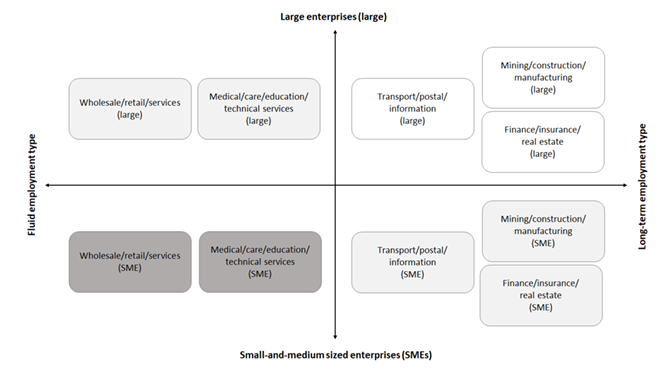JILPT Research Report No.210
The Future of the Japanese Long-Term Employment Society:
The Consequences of Post-Industrialization and Increase of Unmarried Workers
March 31, 2021
Summary
Research Objective
As a sequel to The Future of the Japanese-style Employment System (Project Research Series on the JILPT 3rd Midterm Project), this research is intended to consider the outlook for long-term employment―one of the most important and strongest pillars of the Japanese-style employment practice, and clarify conditions for its maintenance as well as conditions for its collapse.
Research Method
The research was conducted from the two standpoints of labor demand and labor supply. The researchers were split into an “enterprise survey team” that focused on personnel/labor management in enterprises and an “individual survey team” that focused on the employment behaviors of individuals. The individual survey team that prepared this report conducted a questionnaire survey that targeted individual males and females aged between 25 and 64 throughout Japan.
Key Findings
- Even among large non-manufacturing enterprises, “finance and insurance; real estate and goods rental and leasing,” and “transport and postal activities; information and communications” show tendency toward long-term continued employment that is similar to those of secondary industries such as manufacturing, etc. However, in the service industry, the “first job continuity rate” is low and there is a great job mobility.[Note 1] Job changes between the “long-term employment type” sector and “fluid employment type” sector are few, suggesting that two kinds of labor markets coexist (Figure 1).
- Women were not eligible for long-term employment, but the younger generation is gradually continuing to work for first-time companies. However, a tendency is seen whereby married women stay with their companies while unmarried women have more employment mobility. Nevertheless, the inclination to stay with their companies also rises among unmarried women when they begin assisting elderly parents.
- The gap between the fluid employment type and the long-term employment type is not large in terms of job satisfaction and anxiety of job loss. However, the fluid employment type has lower wage levels than the long-term employment type and does not appear to have good opportunities to earn higher wages through job changes.
- There is an aspect whereby thinking that places greater priority on doing the job one wants to do over employment security drives job changes. When “tasks,” which constitute a work unit smaller than “job” and “duty,” are similar, it is possible to change jobs without suffering disadvantages in terms of wages.
Note 1. Due to the constraints of the sample size, this report divides the service industry into professional services in the broad sense (“medical, health care and welfare,” “education, learning support,” and “scientific research, professional and technical services”) and interpersonal services that involve dealing with customers and sales, etc. (“wholesale and retail trade,” “accommodations, eating and drinking services,” and “services, N.E.C.”). Trends toward employment fluidity are seen in both categories.
Figure 1. Employment system types by industry

Click to enlarge
Note: Industries abbreviated as above refer to the followings: “Mining/construction/manufacturing” for Mining and quarrying of stone and gravel; construction; manufacturing, “Finance/insurance/real estate” for Finance and insurance; real estate and goods rental and leasing, “Transport/postal/information” for Transport and postal services; information and communications, “Wholesale/retail/services” for Wholesale and retail trade; accommodations, eating and drinking services; amusement services; services, N.E.C., and “Medical/care/education/technical services” for Medical, health care and welfare; education, learning support; professional and technical services.
Policy Implications
- Long-term employment is being maintained as a safety net even in the non-manufacturing sector.
- However, fluid employment type is also growing as fewer people get married and the economy becomes more service-oriented.
- The development of transferable skills based on tasks (i.e., skills that can be carried across companies) is effective in helping people find good employment opportunities and change jobs.
Policy Contribution
This report provides basic knowledge that will be useful in considering future labor policy.
Contents (available only in Japanese)
- JILPT Research Report No.210, full text (PDF:7.1MB)
- Cover – Preface – Authors - Contents (PDF:547KB)
- Introduction: Purpose and Outline of the Research (PDF:1.1MB)
- Part I: The Realities of Long-Term Continued Employment and Changes of Employment (PDF:3.2MB)
- Part II: Increase of Unmarried Workers and the Careers of Males and Females (PDF:1.2MB)
- Part III: Questioning the Value of Stable Employment (PDF:1.4MB)
- Appendix: Questionnaire Sheet for the “Survey on Occupation and Working Life” (PDF:1.0MB)
If it takes long to download the whole text, please access each file separately.
Research Categories
Project Research Series “Research on Employment Systems”
Sub-theme:“Research on Employment Systems that Adapt to Changes in the Industrial and Demographic Structure”
Research Period
April 2017 - March 2021
This report is the interim report of the “Research on Employment Systems that Adapt to Changes in the Industrial and Demographic Structure (Individual Survey Team),” which is being conducted by JILPT for a five-year period between 2017 and 2021.
Editor
- IKEDA Shingou
- JILPT Senior Researcher
Category
Employment / Unemployment, Workers' life / Workers' awareness
Related Research Results
- Project Research Series No.4 on the JILPT 3rd Midterm Project, The Future of the Japanese-style Employment System (2017).
- Discussion Paper 21-10, Nihon Kigyo ni okeru Jinji Seido Kaikaku no 30-nen-shi [A thirty-year history of personnel system reforms in Japanese companies] (2021).
JILPT Research Report at a Glance
| To view PDF files, you will need Adobe Acrobat Reader Software installed on your computer.The Adobe Acrobat Reader can be downloaded from this banner. |

